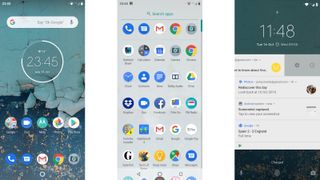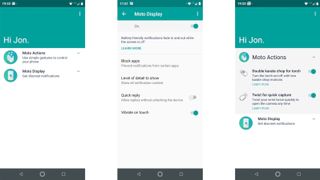Interface and reliability
- Stock Android 8.1 Oreo
- Moto Display and Moto Actions still included
As we’ve already outlined, the Motorola One is defined by its software. You’re getting stock Android 8.1 Oreo more or less the way Google’s engineers intended it.
It’s not a 1:1 match for the Pixel series, but it is a very clean and inviting mobile OS. Google’s round icons, distinctive fonts, and crisp white menus are a joy to navigate through.
The Android One program is built on a foundation of performance optimization, and sure enough it all moves along very smoothly on the mid-range Motorola One. We didn’t encounter any stalls or stutters in general day to day usage.

Google Assistant is also present and accounted for, though you can’t wake the Motorola One from sleep with the "OK Google" vocal prompt. You’ll need to have the screen on to do so.
While this is an Android One phone, Motorola has still included its most meaningful software tweaks and additions. The ‘double twist’ gesture camera shortcut and the ‘double karate chop’ torch provisions are still activated by default, as are Motorola’s subtle Moto Display notifications.
Neither these Moto Display nor Moto Actions options are as extensive as in other Motorola phones, but it’s good to see the essentials here.

The big advantage of Motorola’s decision to adopt Android One over its own custom take on Android will come with future speedy updates.
Motorola One handsets have already started to receive an upgrade to Android 9.0 Pie, which brings a "new Intuitive Navigation and Recent App, improved Do Not Disturb mode, colorful settings menu, anticipated longer battery life, revamped split-screen and more" according to Motorola.
Less showy but arguably even more important to certain people will be the guarantee of timely security updates from Google. This is one of the more secure mid-range Android phones on the market, all thanks to Android One.
Movies, music and gaming
- 720p display not ideal for media
- 64GB of storage and a microSD slot
Smartphones in general have had a rather bumpy start to post-iPhone X notch-life, and it’s in the media experience where the glitches tend to manifest themselves. Video and landscape gaming content hasn’t always played nicely with these stretched out, asymmetrical displays.
The current solution - on the Motorola One at least - seems to be both functional and a little blunt: ignore the notch altogether.

Both the Netflix and Amazon Video apps make out like the Motorola One screen is a regular rectangle, though they treat the ‘problem’ in subtly different ways. Netflix defaults to a slightly zoomed-in view, making fuller use of the 19:9 aspect ratio - but rounding off the corners just short of the notch.
Amazon sticks to the native aspect ratio of the video, and no amount of hitting that zoom button in the app’s settings menu will change that.
The pre-installed YouTube app sits somewhere in between the two - defaulting to an Amazon-like bordered view, but with a pinch gesture serving to zoom in to that curved, notch-omitting view.

Games all seem to go the Netflix route, filling out the screen up to and excluding the notch. It actually works pretty well, but further calls into question the whole point of such a design decision.
Whatever the source of the media content, it all looks okay on the Motorola One’s 5.9-inch display. However, that 720p resolution means that none of it reaches its pin-sharp 1080p potential. And that’s certainly noticeable.
You don’t get stereo sound with the Motorola One, but its single bottom-mounted speaker is plenty loud and clear enough. You’ll likely find your finger covering the speaker during landscape-oriented games if you’re not careful, though.
The phone’s audio credentials are bolstered by the presence of that 3.5mm jack - something that’s started disappearing from the mid-range in the same way that it vanished from the top end of the market.
For audio playback you get Google’s Play Music as standard. It’s a decent piece of playback software and a strong streaming service in its own right, should you choose to sign up for it.
On the media storage front, you get both an ample 64GB of storage as standard and a bonus microSD card slot. This isn’t particularly unusual here at the 2018 Android mid-range, but it still feels like a generous provision.
Specs and benchmark performance
- Snapdragon 625 with 4GB of RAM provides adequate performance
- You can get faster for the money
Motorola has equipped the One with a Snapdragon 625 chipset. As mid-range processors go it’s reasonably capable, but it’s also getting a little long in the tooth.
This is the chip you’ll find in the likes of the two-year-old Moto Z Play and last year’s Moto G5S Plus. On the plus side, it’s backed by a healthy 4GB of RAM.
The result of this setup is generally fluid performance for the most part. Navigating through the home screens and flicking between apps is plenty fast enough, as you might expect - though Android One doubtless helps with that.
Slightly more demanding tasks like using the fingerprint sensor and jumping into the camera app from a sleep state aren’t the quickest processes around, but nor are they irritatingly sluggish.

Gaming is a bit of a mixed bag. Guns of Boom runs fairly fluidly, while less demanding fare like Badland Brawl and Alto’s Odyssey are pretty much faultless. On the other hand, PUBG needs to operate on the lowest possible settings, and Asphalt 9 isn’t even compatible with the phone.
An average Geekbench multi-core score of 4,251 isn’t bad at all, and would seem to match the similarly priced Moto G6 Plus (which scored 4,167). But do bear in mind that the G6 Plus and its Snapdragon 630 CPU attain that score while driving a Full HD display.
The Honor 8X hammers the Motorola One in the performance stakes, scoring 5,552 points with its custom Kirin 710 CPU. And this despite it having a 1080p display and a relatively cumbersome custom UI.
We should also point out that you can get much better performance with a 1080p display and at a potentially lower price, but with similar Android One perks, in the slender form of the Xiaomi Mi A2. That phone uses the newer Snapdragon 660 to impressive effect.
Source: Techradar.com







0 Comments